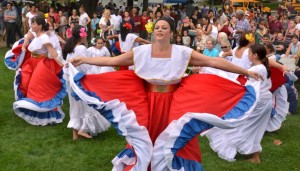Click on each question below to go to the answer below.
- Am I supposed to be colorblind?
 Aren’t we all just one human race?
Aren’t we all just one human race? - How can those of us who are white become better allies for ending racism?
- What are the racial demographics of Amherst?
- Is the word “Caucasian” appropriate?
Am I supposed to be colorblind?
NO! You’re not supposed to be colorblind. People who say they don’t notice race are either lying to you or very unaware. Of course we notice race. We all do. And that’s okay. If you didn’t notice race you would be missing a lot of information about people’s cultures and likely experiences with oppression. How could you notice or interrupt racism if you didn’t see skin color? Dr. King did not say he wanted people to be blind to the beautiful color of little black girls’ and boys’ skin; he said he didn’t want those children “judged” on the basis of the color of their skin. We believe people can notice and appreciate differences in skin color without making negative judgments about people.
The attempt to be colorblind is a nation-wide deception that benefits those who gain power or money when racism is unchallenged. Every time you try to be colorblind or pretend to be colorblind you are colluding with the forces that make racism continue. If you are white and say you are colorblind, you are signaling most people of color that you cannot be counted on as an ally against racism. Please, notice race, everywhere you can.
Aren’t we all just one human race?
Yes. Human beings are tremendously alike. Our DNA is 99.9% the same. While we do differ in appearance, those differences are not linked genetically to any other significant differences, and don’t create discrete sets of people with a common genetic make-up or clusters of other attributes. In other words, “races” do not exist genetically or biologically.
“Race” is a social/historical/cultural construct – a set of ideas and relations – that did not exist through most of human history. The ideas first began to emerge in conjunction with Western European exploration and colonization in Africa, Asia, and the Americas, beginning in the 15th century. “Race” did not become a significant factor in what is now the United States until quite late in the 17th century, where it emerged as a justification for the (already begun) enslavement of Africans and stealing land from the native population. Later the negative notions related to race were extended to Latinos, Asians, etc. “Current scholarship suggests that human races exist solely because we created them and only in the forms that we perpetuate them,” according to Alan Goodman of Hampshire College and his colleagues in a relatively new book (“Are We So Different?” p 10).
While “races” don’t exist genetically, the social construct of “race” exists, has tremendous power, and in the United States affects everyone. It plays a huge role in the distribution of wealth and power, and results in racially discriminatory effects in health care, employment, education, criminal justice, etc. As humans we are all one race or species, and we need to pay attention to the social/cultural construction that is race, so we can dismantle both race and racism.
How can those of us who are white become better allies for ending racism?
1) We need to learn more about contemporary racism and the experiences of people of color today.
2) Because race is an emotional issue and we all have feelings about it, we need to feel our feelings, talk about them with others, and allow our hearts to be touched by how racism is affecting people. If we can allow ourselves to cry, rage, laugh, and tremble, our capacity to be effective allies will grow more quickly.
3) We need relationships with people of color. This is not so people of color will teach us, but rather so we can have the humanizing experience of being connected across lines that have attempted to divide us from our fellow human beings.
4) We need to learn to recognize racism wherever it exists, to speak out against it, and to work collectively with others to dismantle it.(This is a short answer. Other readings and sections of this website suggest more extended answers to this question.)
What are the racial demographics of Amherst?
In Amherst itself, roughly one person out of every four is a person of color. According to the 2010 census the population is approximately:
75% White
9% Asian
7% Latino
6% Black or African American
4% Multi-racial
Roughly one half of grade K-12 students are students of color.
Is the word “Caucasian” appropriate?
Finding words for racial categories is always somewhat problematic because “races” are socially constructed and don’t exist as distinct biological groups. The word “Caucasian” comes out of racist pseudo-science in the 1700’s, which put people from the Caucasus Mountains region (between the Caspian and Black Seas) and Europeans together in one “race” that was seen as the most beautiful and created in “God’s image”. All other “races” were “scientifically” viewed as inferior.
Because the word comes out of discredited racial “science”, conveys a false sense of scientific authority, and does not now suggest anything cultural or even geographical, its use is widely seen as reinforcing old racist ideologies, and is not recommended. Terms such as European-American, Irish-American, Polish-American, etc. are helpful in conveying cultural origins, when appropriate. It is useful, however, to have a more general term that denotes all those assigned to the dominant group in the current racial system in the United States. The term “white” is generally accepted as the most useful one available. We need to constantly remind ourselves that “white” is a socially constructed notion, not a biologically distinct group, even as we use the term to identify a social identity of particular individuals or groups.
